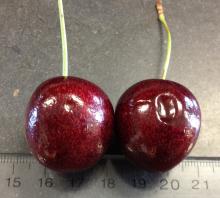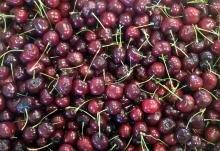Cause There are many reasons that cherries may develop surface depressions or "pits" on the outside of the fruit. The most common cause is physical damage during harvest or postharvest handling. As a response to this damage pits may appear after a few days in cold storage. Some cultivars, such as Van, Lapins, and Sweetheart are more sensitive than others. The following cultivar list is from resistant to pitting to susceptible: Regina, Chelan, Bing, Skeena, Sweetheart, Lapin and Rainer. Dropping the cherry against a hard surface such as a picking bucket or during packing are common causes of pitting. This type of damage increases at lower fruit temperatures.
There are other causes for pitting. The fungi that cause brown rot or cherry leaf spot, and certain viruses (such as the petunia asteroid mosaic virus) and even the bacterium Pseudomonas syringae can cause preharvest pitting. Harvest of over-mature fruit as well as over cropping have also been implicated in causing cherry pitting. However, fruit pitting due to these other causes is not common in the absence of the other more common factors.
Symptoms Normal appearing cherry fruit develop surface depressions that are generally circular and may be broad or sharp. Sometimes a small bit of necrotic tissue may be seen at the bottom of a pit. Pits may range in size from small subtle depressions to large depressions in the side of the fruit.
Cultural control
- Control fungal diseases that may be prevalent in your area.
- Harvest when fruit is at the red mahogany stage.
- Prune Lapins and Sweetheart cultivars hard to reduce the potential for oversetting the crop.
- Avoid dropping fruit, especially once it is chilled.
- Six, weekly preharvest applications of chelated calcium at 0.05% calcium or Cal-8 at 0.2 calcium increased fruit calcium and decreased pitting. High rates can cause marginal leaf burn. Calcium in hydro-cooling water postharvest may also decrease pitting.
Reference Wang, Y., Xie, X., and Long, L.E. 2014. The effect of postharvest calcium application in hydro-cooling water on tissue calcium content, biochemical changes, and quality attributes of sweet cherry fruit. Food chemistry 160:22-30.



